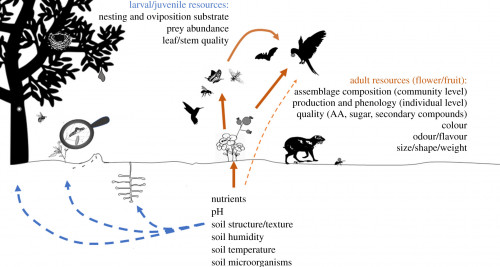A co-funded study, conducted by project partner Spanish National Research Council in collaboration with the Federal University of Goiás, University of Coimbra and the Centre for Ecology, Evolution and Environmental Changes, investigates the impact of human-induced changes in soil properties on pollinators and seed dispersers, as well as the mechanisms by which these alterations propagate to affect these vital ecosystem functions.
Pollination and seed dispersal are performed by a diverse array of animals and significantly contribute to crop production and plant population maintenance. However, human activities have drastically altered soil properties, impacting plants at various levels. Yet little is understood about how these changes affect pollinators and seed dispersers directly. Existing research indicates that the effects of soil changes on these animals vary depending on species, with some benefitting from soil nutrient enrichment while others are adversely affected, likely influenced by diet preferences. Understanding the mechanisms by which soil changes propagate to affect pollinators and seed dispersers is crucial for predicting and mitigating the impacts of environmental changes and devising effective conservation strategies and therein lies the aim of this study.
Image: Diversity of feeding resources used by pollinators, during larval or adult stages, that can be affected by soil properties.
Soil characteristics regulate plant physiology and floral abundance, affecting plant distribution, phenology, and resource availability for pollinators and seed dispersers. Changes in soil properties such as nutrient levels, pH, and humidity impact flower and fruit morphology, nectar and pollen production, and quality, influencing foraging behaviour and fitness of these species. Additionally, soil alterations can modify secondary compounds related to floral volatiles, further influencing pollinator and seed disperser foraging activity. Recognising the diversity of resources utilised by consumers is crucial, as soil changes affect the behaviour and physiology of insects during their immature stages, while anthropogenic activities disrupt nesting sites and expose ground-nesting species to pesticides. Overall, pollinators and seed dispersers contribute to soil maintenance, particularly in arid environments, highlighting the need for further research and conservation efforts to mitigate these impacts.
You can read more about the impact of human-induced changes in soil properties on pollinators and seed dispersers here.
